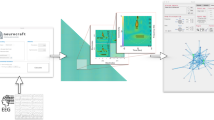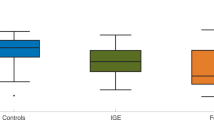Abstract
Epileptic seizures are a principal brain dysfunction with important public health implications, as they affect 0.8% of humans. Many of these patients (20%) are resistant to treatment with drugs1. The ability to anticipate the onset of seizures in such cases would permit clinical interventions. The view of chronic focal epilepsy now is that abnormally discharging neurons act as pacemakers to recruit and entrain other normal neurons by loss of inhibition and synchronization into a critical mass2. Thus, pre-ictal changes should be detectable during the stages of recruitment. Traditional signal analyses, such as the count of focal spike density3, the frequency coherence4 or spectral analyses are not reliable predictors. Non-linear indicators may undergo consistent changes around seizure onset5,6,7. Our objective was to follow the transition into seizure by reconstructing intracranial recordings in implanted patients as trajectories in a phase space and then introduce non-linear indicators to characterize them8,9. These indicators take into account the extended spatio–temporal nature of the epileptic recruitment processes10 and the corresponding physiological events governed by short-term causalities in the time series. We demonstrate that in most cases (17 of 19), seizure onset could be anticipated well in advance (between 2–6 minutes beforehand), and that all subjects seemed to share a similar 'route' towards seizure.
This is a preview of subscription content, access via your institution
Access options
Subscribe to this journal
Receive 12 print issues and online access
$209.00 per year
only $17.42 per issue
Buy this article
- Purchase on Springer Link
- Instant access to full article PDF
Prices may be subject to local taxes which are calculated during checkout



Similar content being viewed by others
References
Sander, J.W. & Shorvon, D. Incidence and prevalence of studies in epilepsy and methodological problems: A review. J. Neurol. Neurosurg . 50, 829–839 ( 1987).
Wyler, A.R. & Ward, A.A. in Epilepsy: A Window to Brain Mechanism . (eds. Lockard, J.S. & Ward, A.A.) 415–422 (Raven, New York, 1992).
Gotman, J., Ives J., Gloor, P., Oliver, A. & Quesney, L.F. Changes in interictal EEG spiking and seizure occurrence in humans. Epilepsia 23, 432– 433 (1982).
Duckrow, R.D. & Spencer, S.S. Regional coherence and the transfer of ictal activity during seizure onset in the medial temporal lobe. Electroencephalogr. Clin. Neurophysiol. 82, 415– 422 (1992).
Casdagli, M. et al. Non-linearity in invasive EEG recordings from patients with temporal lobe epilepsy. Electroencephalogr. Clin. Neurophysiol . 102, 98–105 ( 1997).
Lasemidis, L.D. & Sackellares J.C. in Measuring Chaos in the Brain (eds. Duke D.K. and Pritchard W.S,) 49– 82 (Word Scientific, Singapore, 1991).
Lehnertz, K. & Elger, C.E. Can Epileptic Seizures be predicted? Evidence from Nonlinear Time Series Analysis of Brain Electrical Activity. Physiol. Rev. Lett. 80, 5019– 5022 (1998).
Abarbanel, H.D.I. In Analysis of Observed Chaotic Data 17– 23 (Springer Verlag, 1995).
Lopes da Silva, F.H. & Pijn, J.P. in The Handbook of Brain Theory and Neural Networks (ed. Arbib, M.A.) 367- 369 (MIT Press, Cambridge, 1995).
Lange H.H., Lieb, J.P., <Engel J. & Crandal, P.H. Temporo-spatial patterns of the pre-ictal spike activity in human temporal lobe epilepsy, Electroencephalogr. Clin. Neurophysiol. 56, 543– 555 (1983).
Lachaux, J.P. et al. Spatial extension of brain activity fools the single-channel reconstruction of EEG dynamics. Hum. Brain Mapping 5, 26–47 (1997).
Prichard, D. & Theiler, J. Generating surrogate data for time series with several simultaneously measured variables. Phys. Rev. Lett. 73, 951 (1994).
Manuca, R., Casdagli, M. & Savit, R. Nonstationarity in Epileptic EEG and Implications for Neural Dynamics. Math. Biosci. 147, 1– 10 (1998).
Schiff, S. et al. Controlling chaos in the brain. Nature 370, 615–620 (1994).
Velasco, F. et al. Electrical stimulation of the centromedian thalamic nucleus in control of seizures: long-term studies. Epilepsia 36, 63–71 (1995).
McLachlan, R.S. Vagus nerve stimulation for intractable epilepsy: A review. J. Clin. Neurophysiol. 14, 358–68 (1997).
Weiser, H.G. In Reflex Seizures and Reflex Epilepsies (eds. Beaumanoir, A., Gastaut, H. & Naquet, R.) 49–55 (Médecine et Hygiène, Genève, 1989).
Rosenstein, M.T., Collins, J.J. & De Luca, C.J. Reconstruction expansion as a geometry-based framework for choosing proper delay times. Physica D 73, 82–98 (1994).
Lerner D. Monitoring changing dynamics with correlation integrals : Case study of an epileptic seizure. Physica D 97, 563– 576 (1996).
Casdagli, M. Recurrence plots revisited. Physica D 108, 12–44 (1997).
Acknowledgements
We thank T. Schreiber and Y. Okada for discussions. The support of Human Science Frontier Program (RG-92/97) is acknowledged.
Author information
Authors and Affiliations
Rights and permissions
About this article
Cite this article
Martinerie, J., Adam, C., Quyen, M. et al. Epileptic seizures can be anticipated by non-linear analysis. Nat Med 4, 1173–1176 (1998). https://doi.org/10.1038/2667
Received:
Accepted:
Issue Date:
DOI: https://doi.org/10.1038/2667
This article is cited by
-
Mean amplitude spectrum based epileptic state classification for seizure prediction using convolutional neural networks
Journal of Ambient Intelligence and Humanized Computing (2023)
-
RETRACTED ARTICLE: A novel approach based on BSPCI for quantifying functional connectivity pattern of the brain’s region for the classification of epileptic seizure
Journal of Ambient Intelligence and Humanized Computing (2021)
-
Nonlinear Analysis of Visually Normal EEGs to Differentiate Benign Childhood Epilepsy with Centrotemporal Spikes (BECTS)
Scientific Reports (2020)
-
Tsallis entropy: as a new single feature with the least computation time for classification of epileptic seizures
Cluster Computing (2019)
-
A new look to coma from the viewpoint of nonlinear dynamics
Nonlinear Dynamics (2018)



